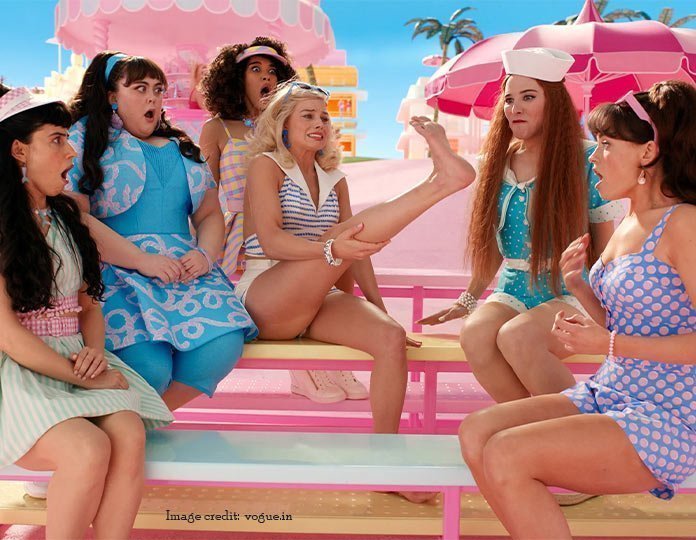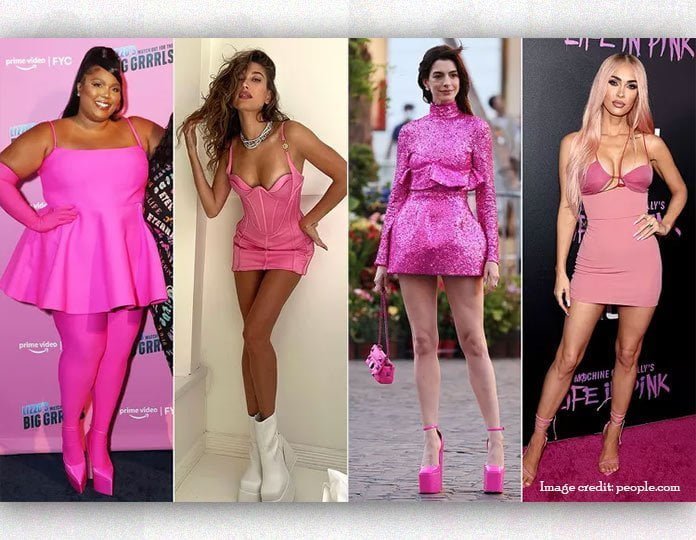Barbiecore, a fad inspired by the popular Barbie doll, has swept the internet by storm, especially with the news of a new Barbie film set to release in July 2023. The aesthetic promotes self-expression and body positivity by embracing traditionally feminine and “girly” elements. Many young women experience tension and worry as a result of conventional beauty standards, whereas Barbiecore fosters a sense of amusement and enjoyment.
Barbiecore
Barbiecore is a trendy aesthetic trend, based on Mattel’s renowned fashion doll, Barbie. On TikTok alone, the hashtag #BarbieCore has over 186.4 million views. It takes us back to the 1990s and early 2000s, when bright pink was all the rage and glitter was everywhere.
Barbie’s stylish sense of fashion and ability to adapt to the current trends while putting her own twist on them has made her a fashion icon for many. Barbie has a look for any occasion, from dazzling ball gowns to riding boots, rainbow-colored wings to surfboards. Barbiecore’s basic visual traits include everything considered feminine, pleasant, occasionally intriguing, and unmistakably pink.
A shift in Barbie’s Physical transformation
The Barbiecore digital advertising revolution corresponded with a physical change of Barbie, which included:
- Skin tones that are more diverse
- Additional hairstyles and textures
- various heights
- A greater variety of body forms
- Differences that can be seen
- Gender equality
- Wheelchairs, hearing aids, and prostheses are examples of assistive devices.
Barbie has also embraced feminist themes, including the #CloseTheDreamGap and Sheroes campaigns, as well as the Inspiring Women’s Collection, to promote inclusion and social justice.

The Power of Pink
Pink has long been connected with Barbie and is frequently regarded as a sign of femininity, beauty, and innocence. Pink and femininity have been linked as potentially reinforcing gender stereotypes and limiting children’s play possibilities, particularly in toys sold to females. This link may also contribute to the stigmatization of boys who display an interest in typically female-oriented toys. Despite these reservations, the power of pink can be beneficial.
Pink can be used to promote self-expression and mental wellness when utilized in a way that promotes variety and inclusivity; one example is the “Pink Ribbon” campaign for breast cancer awareness.
Movie’s Plot and Psychology Behind Pink
Barbiecore 2023 immerses us in the life of a one-of-a-kind Barbie who faces expulsion from Barbieland due to her idiosyncrasies and inability to fit to society’s rigid standards of perfection. Her trip into the real world, serves as a catalyst for growth, self-discovery, and startling revelations. She finds along the way that genuine perfection lies within, radiating inner beauty and strength.
She becomes a symbol of empowerment as she returns to Barbieland, challenging traditional beauty standards and altering ideals of femininity. Pink, a key component of the Barbiecore aesthetic, has psychological importance, evoking thoughts of comfort and nurture. It promotes serenity and reduces stress by acting as a stimulus for self-soothing and emotional management.
This inclusive movement promotes diversity within the Barbiecore community, demonstrating the transformational power of accepting one’s actual self and promoting positive mental health.
Risk of Aesthetic Obsession
Barbiecore, with its beautiful image and idealized beauty standards, maybe a creative and self-expression-inspiring outlet. However, there are drawbacks to getting unduly infatuated with this aesthetic, especially in terms of mental health.
- Perfectionism has increased: One notable concern is the development of heightened perfectionism, a psychological trait characterized by the pursuit of perfection and exceedingly high-performance standards. Barbiecore’s high beauty standards can intensify this characteristic in persons who are already prone to perfectionism.
- Anxiety: As adolescents seek to bridge the gap between their real appearance and the idealized Barbie image, the constant pursuit of perfection can cause anxiety. The pressure to comply with certain aesthetic standards might lead to low self-esteem since they may feel inadequate or incapable of meeting these expectations.
- Focus on physical appearance: Furthermore, the Barbiecore aesthetics’ emphasis on physical appearance may overshadow other important components of one’s identity, such as skills, abilities, and personality qualities. This reductionist self-image can have a negative impact on mental health and personal development.
Body dissatisfaction and mental health issues
Body dissatisfaction is a prevalent problem that offers a considerable public health risk, particularly among young girls, with more than half of preadolescents affected.
Barbiecore, with its obsession on perfection, can cause significant body dissatisfaction and accompanying mental health difficulties in its devotees. People have long chastised Barbie dolls for their exaggerated proportions and immaculate beauty, which can lead to unhealthy beauty standards
These features are important to the Barbiecore aesthetic and, pushed to its logical conclusion, can result in the following:
- Body Dysmorphia
- Eating disorders
- Self-esteem issues
Social media’s frequent exposure to curated, ‘perfect’ photographs exacerbates these concerns, leading to feelings of inadequacy and dissatisfaction with one’s own appearance and life.
Is Barbie Core Only For Women?
The term “Barbiecore” conjures up images of a specific aesthetic and style that is associated with femininity. However, barbiecore is not just for girls. It can be embraced by anyone, regardless of their gender identity.
In reality, the inclusiveness and diversity of Barbiecore are intended to dignify and empower all individuals, regardless of gender, body type, or origin. It is a movement that emphasizes self-expression, self-love, and acceptance of oneself and others.

The body positivity and diversity movements of Barbiecore might influence future attitudes towards mental health. The tendency towards diverse Barbie doll representation can foster inclusiveness and acceptance of variety, which can heighten empathy and lessen stigmatisation for those who may be dealing with mental health issues.
Barbie’s acceptance of feminism has the potential to promote self-esteem and empowerment, both of which are advantageous to mental health. There are downsides, meanwhile, including the propagation of unattainable aesthetic standards and the threat of cultural appropriation. The Barbiecore movement needs to put diversity, inclusivity, and social responsibility first in order to continue to have a good impact on mental health in the future.
What can parents do to limit the risk of Aesthetic Obsession?
Parents have an important role in forming their child’s perspective and can take many actions to reduce the potential detrimental mental health effects of Barbie doll play:
1) Promote open communication: Maintain an open and positive dialogue with your child on body image, self-esteem, and beauty standards.
2) Purchase a diverse selection of toys: Introduce toys that depict a range of body sizes, races, and abilities to promote inclusivity and diversity.
3) Value your inner traits over outward appearances: Encourage your youngster to value values such as kindness, intelligence, and empathy over outward appearances.
4) Limit your exposure to media: Avoid media and social media content that promotes unrealistic beauty ideals and invites comparisons.
5) Encourage self-acceptance: To help your child develop a healthy self-image, encourage self-acceptance and emphasise your child’s unique talents and strengths.
6) Provide context as well as knowledge: To help your child distinguish between fiction and reality, explain photo editing, airbrushing, and the unrealistic nature of media depictions.
7) Seek expert help if necessary: If you notice recurring signs of low self-esteem or negative body image, consider seeing a mental health specialist who specialises in working with children and adolescents.
Barbie has brought delight and countless hours of imaginative play to generations of youngsters. However, we must recognize the potential mental health dangers connected with artificial beauty standards and comparisons, which can have an influence on a child’s mental health. We can negotiate the challenges and ensure a healthier self-image for children by recognizing these hazards, supporting self-acceptance, and encouraging open communication.













Leave feedback about this